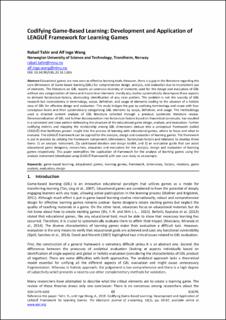| dc.contributor.author | Tahir, Rabail | |
| dc.contributor.author | Wang, Alf Inge | |
| dc.date.accessioned | 2020-09-14T11:00:49Z | |
| dc.date.available | 2020-09-14T11:00:49Z | |
| dc.date.created | 2020-05-25T17:27:33Z | |
| dc.date.issued | 2020 | |
| dc.identifier.citation | Electronic Journal of e-Learning. 2020, 18 (1), 69-87. | en_US |
| dc.identifier.issn | 1479-4403 | |
| dc.identifier.uri | https://hdl.handle.net/11250/2677641 | |
| dc.description.abstract | Educational games are now seen as effective learning tools. However, there is a gap in the literature regarding the core dimensions of Game-based learning (GBL) for comprehensive design, analysis, and evaluation due to inconsistent use of elements. The literature on GBL reports an extensive diversity of elements used for the design and evaluation of GBL without any categorization of micro and macro-level elements. Hardly any studies systematically decompose these aspects to derivate factors/sub-factors, obstructing identification of any clear pattern. The problem is not the scarcity of GBL research but inconsistency in terminology, scope, definition, and usage of elements leading to the absence of a holistic view of GBL for effective design and evaluation. This study bridges the gap by outlining terminology and scope with four conceptual levels and then systematically categorizing GBL elements by scope, definition, and usage. The methodology used is directed content analysis of GBL literature collected through a previous systematic literature review. Dimensionalization of GBL and further decomposition into factor/sub-factors based on theoretical constructs, has resulted in a consistent and clear pattern delineating the structure of the educational game design, analysis, and evaluation. Further codifying metrics and mapping the relationship among GBL dimensions deduce into a conceptual framework that facilitates greater insight into the process of learning with educational games, where to focus and what to evaluate. The LEAGUE framework can be applied for the design, analysis, and evaluation of educational games. The framework is put in practice by utilizing the framework components to develop three items: LEAGUE analysis instrument, LEAGUE ideation and design toolkit, and LEAGUE evaluation guide that can assist educational game designers, researchers, and evaluators. This paper exemplifies the analysis of learning games using the LEAGUE analysis instrument with one case study as an example. | en_US |
| dc.language.iso | eng | en_US |
| dc.publisher | Academic Conferences and Publishing International | en_US |
| dc.rights | Navngivelse 4.0 Internasjonal | * |
| dc.rights.uri | http://creativecommons.org/licenses/by/4.0/deed.no | * |
| dc.title | Codifying Game-Based Learning: Development and Application of LEAGUE Framework for Learning games | en_US |
| dc.type | Peer reviewed | en_US |
| dc.type | Journal article | en_US |
| dc.description.version | publishedVersion | en_US |
| dc.source.pagenumber | 69-87 | en_US |
| dc.source.volume | 18 | en_US |
| dc.source.journal | Electronic Journal of e-Learning | en_US |
| dc.source.issue | 1 | en_US |
| dc.identifier.doi | 10.34190/EJEL.20.18.1.006 | |
| dc.identifier.cristin | 1812516 | |
| dc.description.localcode | This work is licensed under a Creative Commons Attribution 4.0 International License | en_US |
| cristin.ispublished | true | |
| cristin.fulltext | postprint | |
| cristin.qualitycode | 1 | |

